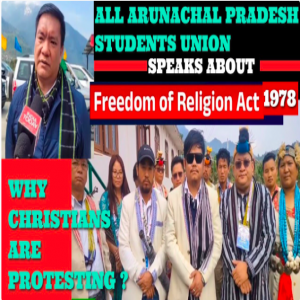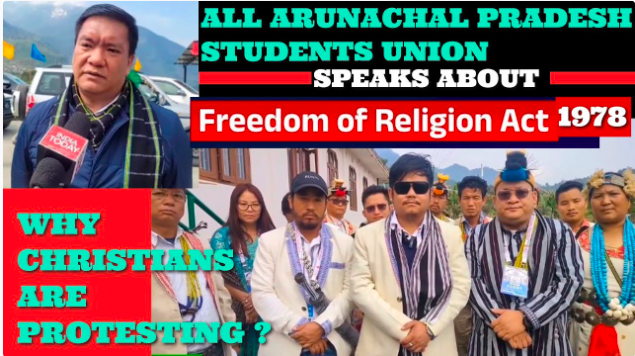

When Tani Taba (name changed), a 17-year-old student from Ziro Valley, stood up during a village youth fellowship and shared how the Gospel helped him overcome the shame of being born into a "low ritual status" clan, the elders listened in silence. His story wasn't about conversion—it was about dignity. "I didn't change my tribe," he said. "I found a new way to love it."
Across Arunachal Pradesh, stories like Tani's have quietly reshaped the religious landscape—not through coercion, but through courage. In classrooms, hostels, and village gatherings, young people became the unlikely evangelists of a faith that offered healing, hope, and belonging. Their witness, more than any legal argument, rendered the state's anti-conversion law toothless.
A Law Born of Cultural Anxiety
The Arunachal Pradesh Freedom of Religion Act, 1978, emerged during a politically volatile era when the state was still a Union Territory. Its stated aim was to prevent conversions through force, fraud, or inducement. But beneath the surface lay deeper anxieties—an effort to enforce Hindu identity in a region where Christianity was gaining ground. Government-sponsored Hindu groups, such as the Ramakrishna Mission, Sharada Mission, and Vivekananda schools, played a significant role in shaping this narrative.
Ironically, despite the Act's enactment, the Christian population grew from less than 1% in the 1970s to over 30% by 2011. Though passed with Presidential assent, the law was never operationalised. Successive governments, wary of alienating the growing Christian demographic, refrained from framing enforcement rules. Even Chief Minister Pema Khandu, in 2018, publicly considered repealing the Act, citing its incompatibility with secular values.
Civil Resistance and Constitutional Courage
From the outset, resistance was vocal and principled. MP Bakin Pertin, a Christian leader, opposed the Act before it was enacted. The Arunachal Christian Forum (ACF), formed in 1979, consistently argued that the law violated constitutional guarantees of religious freedom.
Even the Act's original architect, Oken Lego—a Christian convert—later clarified that his intent was to protect the right to convert, not suppress it. Ironically, Christian organisations grew wary of the law, fearing that legalising conversion might invite scrutiny and backlash.
In 2022, a Public Interest Litigation filed by advocate Tambo Tamin reignited the debate. The Gauhati High Court directed the state to frame rules within six months. But the backlash was swift: protests, hunger strikes, and civil mobilisation underscored the law's incompatibility with Arunachal's pluralistic soul.
Youth as Evangelists of Hope
What truly rendered the law ineffective was not just legal inertia—but the transformative power of youth-led evangelism. Students, educated in missionary schools outside Arunachal Pradesh, became cultural translators of the Gospel. They didn't impose faith; they embodied it.
Rosy Perme (name changed), a 22-year-old nursing student from Itanagar, recalls: "I first heard about Jesus in a school assembly. What stayed with me wasn't the sermon—it was the kindness of my teacher who prayed with me when my mother was sick. That's when I knew faith could be personal, not just ritual."
Christianity offered a liberating narrative, especially for those burdened by social taboos. It became a grassroots movement, not a missionary imposition. The demographic shift was not engineered—it was embraced.
Tadar Nima (name changed), 19, a college youth leader from Papum Pare, shares: "We didn't need missionaries to tell us what to believe. We saw how our seniors lived—with joy, with purpose. That's what drew us in. We translated the Bible into our dialect not to convert others, but to understand it ourselves."
Faith, Identity, and the Battle for Belonging
In 2025, a pastor's remark declaring Arunachal a "Christian land" sparked outrage, revealing the fragile fault lines of identity politics. Organisations like the Indigenous Faith and Cultural Society of Arunachal Pradesh condemned it, fearing cultural erasure. Yet, this moment also highlighted the need for interfaith storytelling—not as a battleground, but as a bridge.
Rev. Toko Anna, a pastor and former school principal, reflects: "The law never scared us. What worried me was the silence in our villages—people afraid to speak about faith. But when students began sharing their testimonies, the silence broke. That's when the real change began."
Even those outside the Christian fold recognise the impact. Nyadar Tali, a social worker and Donyi Polo practitioner, observes: "I don't follow Christianity, but I respect how young Christians serve our community. They run tuition centers, help during floods, and never ask for anything in return. That's the kind of interfaith we need."
A Gospel of Invitation, Not Imposition
Arunachal's youth didn't just defang a law—they redefined evangelism. Their witness was not coercive, but invitational. In doing so, they upheld the constitutional promise of freedom of conscience and the Gospel's call to love without compulsion.
The Arunachal Pradesh Freedom of Religion Act, 1978, may still exist on paper, but its spirit has been outlived by a generation that chose storytelling over suppression, dignity over dogma, and pluralism over paranoia.
Fr. CC Jose, a pioneering Salesian missionary in Itanagar and co-editor of The Salesians of Don Bosco in Northeast India: A Hundred Years of Evangelising Mission, lets out the secret: "Evangelisation in Arunachal was never about numbers—it was about presence. We walked with the people, learned their stories, and let the Gospel speak through service, not slogans."